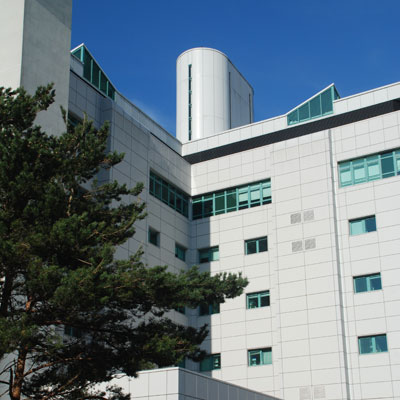Wellcome Trust Centre for Cell Biology
29-March-2011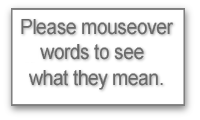
Wellcome Trust Centre for Cell Biology
Biology is complicated these days.
Actually it always was. We just didn't realise it.
Now that scientists can look inside the cells that almost all living things are made of, they've 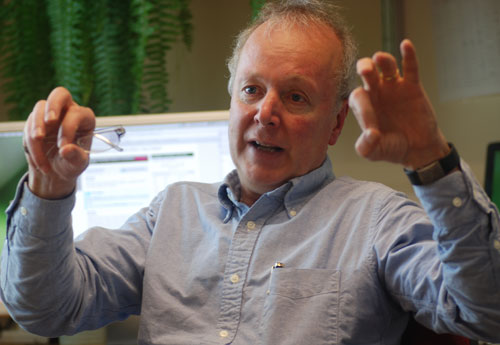 discovered just how many moving parts are in there. Each cell is like central London in the rush hour.
discovered just how many moving parts are in there. Each cell is like central London in the rush hour.
The closer the scientists look, the more complex life seems. But that won't go on forever, says Adrian Bird, director of the Wellcome Trust Centre for Cell Biology at Edinburgh University. "Some biologists believe the world is hopelessly complex. They could be right.
"But I am more optimistic. Things can seem impenetrable when key facts are missing. People once thought proteins couldn’t be understood by ordinary chemistry. Now we know they can. They’re just polymers of amino acids, whose side-chains determine the structure of the protein and what it can do.
"That's all there is to it. And that's a huge simplification.
DNA
Breakthroughs in science are often simplifications, says Professor Bird. "You only have to look at the structure of DNA to see how inheritance works. That's an amazing breakthrough.
"You look at one molecule and it tells you why children resemble their parents."
For some time now scientists have been studying single genes and the proteins they produce, he says. But that is not enough. "In the 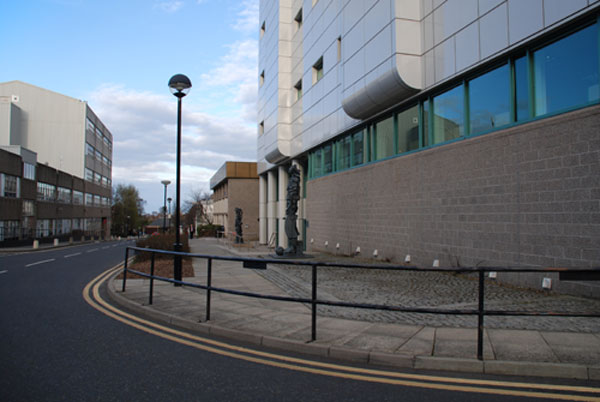 end we're going to have to describe the whole system. These genes all co-exist. Many are expressed at the same time. That has turned out to be very complicated.
end we're going to have to describe the whole system. These genes all co-exist. Many are expressed at the same time. That has turned out to be very complicated.
"What we need are algorithms that tell us why this combination of things with this many interactions is alive. But that won't come quickly. People thought when the human genome was published it was the beginning of the end. It's more like the end of the beginning.
"I believe we have a hundred - maybe several hundred - years of research before we make sense of it all. Some people might not be happy to be part of an enterprise that takes that long. But I am."
At the Centre
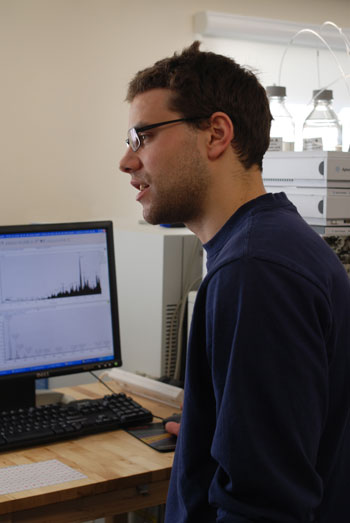 The Wellcome Trust Centre for Cell Biology exists to make discoveries about what happens inside living cells, says Professor Bird. "There is still a lot we don't know. The fact that you can list all the genes doesn’t mean you know how they work.
The Wellcome Trust Centre for Cell Biology exists to make discoveries about what happens inside living cells, says Professor Bird. "There is still a lot we don't know. The fact that you can list all the genes doesn’t mean you know how they work.
"A cell has thousands and thousands of components and we have just 16 group leaders here. So we specialise. But we don't tell people what to look at. Experience shows that breakthroughs are made by good scientists given the freedom to do what interests them."
Research at the Centre currently focuses on four main areas, he says. One is how chromosomes behave during mitosis – when one cell splits into two cells. These should be identical copies. But it is complicated and mistakes often happen.
"When a cell is dividing, the chromosomes first condense," says Professor Bird. "Then they attach themselves to microtubules - sort of ropes - that drag the chromosomes in an elaborate dance."
Miscarriage
When living cells divide, each of the two daughter cells is supposed to end up with the same chromosomes and the same number of them as the original cell. But they don’t always.
"We call it aneuploidy when cells end up with the wrong number of chromosomes,” says Professor Bird.
Aneuploidy causes fertilised eggs, in humans and other mammals, to be lost. Most aneuploid eggs don't attach to the uterus, so the female does not get pregnant. If she does, the embryo with the wrong number of chromosomes is much more likely to miscarry. This is thought to be the cause of the majority of human miscarriages. 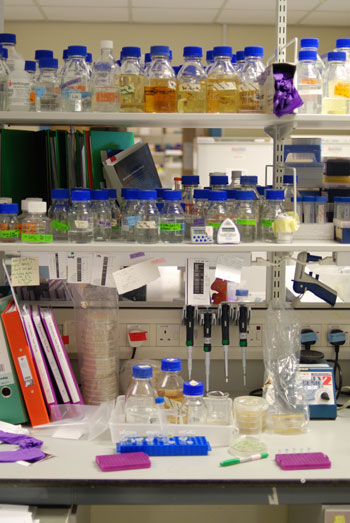
If the egg with the wrong number of chromosomes does implant in the uterus and there is no miscarriage, the baby may have disabilities. What these are depends on which chromosome is involved. The most common in born babies is an extra copy of chromosome 21. This causes Down syndrome.
Cancer cells also have the wrong number of chromosomes, says Professor Bird. "It is clear that aneuploidy contributes to cancer."
More groups
All this research into how chromosomes split, separate and move around, when cells divide, often uses yeast cells, says Professor Bird. "One of those big simplifications I talked about is that different organisms use clearly related proteins to do the same thing.
“When you're trying to understand something you study it in the simplest system. Often that’s yeast. We can manipulate yeast cells genetically and do biochemistry on them, knowing that what we find is likely also to apply to human cells."
Chromosome segregation is the largest area of research at the Wellcome Trust Centre for Cell Biology, says Professor Bird - with five or six groups currently working on it. "Another area is RNA processing, synthesis and stability.
"RNA starts out as a direct copy of the DNA. But then it gets altered, chopped up, spliced together. All these processes are complicated. We have four groups trying to understand them."
Rubbish?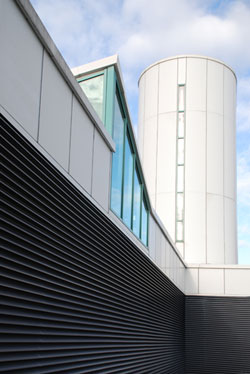
A third area of research at the Wellcome Trust Centre for Cell Biology is epigenetics, says Professor Bird. “That’s my field. We're looking at how gene expression is controlled by marks such as methyl groups added to the DNA. These determine if a gene gets expressed or is silenced.
“There’s a lot of popular interest in epigenetics nowadays, not always for the right reasons. A fair bit of rubbish is talked about how epigenetics means it’s the environment that determines who we are.”
The final area of research is mass spectroscopy, says Professor Bird. "We have a group leader who collaborates with people on their research, and does his own mass spec on the structure of complexes. He recently collaborated with the chromosome people to discover the entire protein composition of a mitotic chromosome.
While these groups are often investigating different parts of living cells, it is enormously useful being all together in one place, he says.
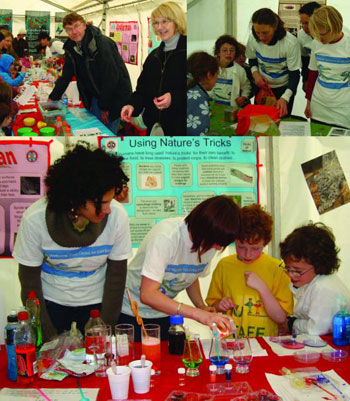 Community
Community
“It's valuable for us all to be in the Wellcome Trust Centre for Cell Biology, instead of scattered around Edinburgh University," says Professor Bird.
Researchers can share ideas and insights over a coffee, he says. Actual research collaborations are quite common. "Then there’s all the infrastructure and shared facilities, such as the optical microscopes and the bioinformatics experts. Everybody needs bioinformatics nowadays."
Regular fellows' meetings present the work of one research group to all the other group leaders, says Professor Bird. "It's an in-depth critique of what you've been doing and where you are going. If somebody thinks you're barking up the wrong tree they say so.”
That culture is vital for good science, he says. "People are not encouraged to say what they mean nowadays. But in science you have to. It clarifies your thinking. It's not an attack on you as a person. It's a way to make progress.
"Like all human beings, scientists need advice.”
Words used in pop-ups
| breed | cell | chemistry | complex | compound | concentrated |
| congenital | contributes | coordinate bonding | covalent | cytoplasm | direct |
| DNA | exon | expel | expulsion | fertile | foetus |
| genes | information technology | inherit | intron | magnify | mass spectrometer |
| mechanisms | membrane | microscopic | molecular biology | molecule | mRNA |
| nucleus | organelle | organisms | peptide | polypeptide | proteins |
| protoplasm | researchers | ribosomes | sample | sequence | species |
| stature | structures | telecommunications | template | tissue | translate |
For other websites and resources relevant to this science story try the

